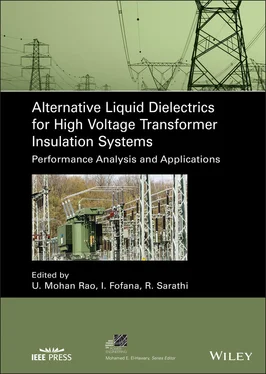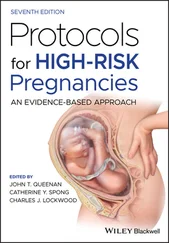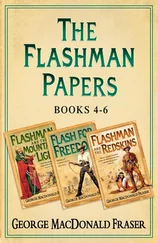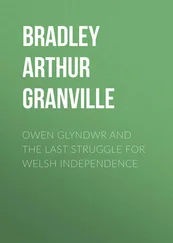The natural esters have an inherently higher viscosity than the MO, which decreases the flowability of the liquid. This hampers the heat transfer across sections inside a transformer and to the exterior. Apparently, this indicates that the heat transfer by the natural esters is lower than the MO. However, this is not always true as for a higher heat transfer coefficient, the thermal conductivity, specific heat, and density are expected to be of higher value, whereas viscosity should be lower. It is certain that the viscosity of the NEOs is higher than the MO. But the higher viscosity of natural esters may be compensated by a much higher thermal conductivity value. Therefore, an optimum point has to be attained where the heat transfer is higher in case of natural esters.
2.8 Conclusions and Future Scope
Insulating liquids form the major part of any insulation system in many types of power apparatus, including transformers, cables, and capacitors. The characteristics of the insulating liquids are different for different applications. MOs are the conventional insulating liquids used in transformers and they have established itself well in this area. They are low‐cost oils with good performance, so for a long time there was no competition to the MO. However, in the recent times, fire safety and environmental concerns have driven the researchers to look for other alternatives to the MO. From the aforementioned observation about the processing and evaluation of NEOs, the following conclusions are summarized:
The petroleum‐based MO has low environmental safety specifications which motivates the scientists for the development of an alternative liquid dielectric for insulation and cooling. Over the years, scientists have found out that the natural ester‐based liquid dielectric is an alternative option to overcome the demerits of petroleum‐based MO.
Natural esters are mostly extracted from the biological seeds such as soybean, pongamia, jatropha, palm fruit, etc., which make them a biodegradable material. Pretreatment of the biological seeds is a mandatory process before extraction of crude natural ester and for better yield.
The extraction of crude oil is divided into two categories, namely mechanical and chemical extraction. Mechanical extraction is used for bulk production of crude oil, whereas chemical extraction is mostly applicable for the laboratory scale. The crude ester oil is considered to be unfit for usage in industrial dielectric liquid applications because of its high viscosity, high acid number, and poor pour point.
Processing of the crude ester oil is required for industrial application. Therefore, the transesterification process is followed for the crude oil to prepare the natural ester for dielectric applications.
In order to ascertain the quality of the natural ester, physicochemical, thermal, and electrical characterization is carried out.
Since natural ester is biodegradable in nature, the chemical and thermal degradation analysis is carried out to understand the degradation behavior of the natural ester.
Postoperative condition of the natural esters in power apparatus are analyzed using the DGA by which incipient faults are detected in the aged oil. These methods include the gas ratio techniques and the Duval’s triangle technique.
So far the dielectric liquid is concerned, natural ester has no hazardous effect to the environment. Therefore, in comparison to the MO, natural ester is considered as a prospective replacement for dielectric applications.
1 1 Fofana, I. (2013). 50 years in the development of insulating liquids. IEEE Electr. Insul. Mag. 29 (5): 13–25.
2 2 Rakesh, C. and Thomas, M.J. (2016). Pongamia oil, an eco‐friendly alternative for mineral oil used in high voltage transformers. In Proc. 2016 IEEE Int. Conf. Dielectr. ICD 2016, vol. 2, pp. 959–962.
3 3 Martins, M. (2010). Vegetable oils, an alternative to mineral oil for power transformers‐experimental study of paper aging in vegetable oil versus mineral oil. IEEE Electr. Insul. Mag. 26 (6): 7–13.
4 4 Farade, R.A., Wahab, N.I.B.A., Mansour, D.E.A. et al. (2020). Investigation of the dielectric and thermal properties of non‐edible cottonseed oil by infusing h‐BN nanoparticles. IEEE Access 8: 76204–76217.
5 5 Martins, M.A.G. (2010). Correction to vegetable oils, an alternative to mineral oil for power transformers–experimental study of paper aging in vegetable oil versus mineral oil. IEEE Electr. Insul. Mag. 26 (6): 7–13.
6 6 Wilhelm, H.M., Stocco, M.B.C., Tulio, L. et al. (2013). Edible natural ester oils as potential insulating fluids. IEEE Trans. Dielectr. Electr. Insul. 20 (4): 1395–1401.
7 7 Das, A.K., Shill, D.C., and Chatterjee, S. (2020). Potential of coconut oil as a dielectric liquid in distribution transformers. IEEE Electr. Insul. Mag. 36 (6): 36–46.
8 8 Beltrán, N., Palacios, E., and Blass, G. (2017). Potential of Jatropha curcas oil as a dielectric fluid for power transformers. IEEE Electr. Insul. Mag. 33 (2): 8–15.
9 9 Sitorus, H.B.H., Beroual, A., Setiabudy, R., and Bismo, S. (2015). Pre‐breakdown phenomena in new vegetable oil – based jatropha curcas seeds as substitute of mineral oil in high voltage equipment. IEEE Trans. Dielectr. Electr. Insul. 22 (5): 2442–2448.
10 10 Trnka, P., Mentlik, V., and Svoboda, M. (2014). Ecologically acceptable insulating liquids for electrical appliances. In Proc. 2014 IEEE 18th Int. Conf. Dielectr. Liq. ICDL 2014, pp. 3–6.
11 11 Oommen, T.V. (2002). Vegetable oils for liquid‐filled transformers. IEEE Electr. Insul. Mag. 18 (1): 6–11.
12 12 Dung, N.V. and Huong, H.L. (2020). The effect of antioxidants on the physical and chemical properties of rice oil, corn oil, peanut oil and Kraft paper. IEEE Trans. Dielectr. Electr. Insul. 27 (5): 1698–1706.
13 13 Kumar, S.S., Iruthayarajan, M.W., Bakrutheen, M., and Kannan, S.G. (2016). Effect of antioxidants on critical properties of natural esters for liquid insulations. IEEE Trans. Dielectr. Electr. Insul. 23 (4): 2068–2078.
14 14 Du, B.X. and Li, X.L. (2017). Dielectric and thermal characteristics of vegetable oil filled with BN nanoparticles. IEEE Trans. Dielectr. Electr. Insul. 24 (2): 956–963.
15 15 Carcedo, J., Fernandez, I., Ortiz, A. et al. (2016). Quantitative study on the aging of kraft paper in vegetable oils. IEEE Electr. Insul. Mag. 32 (6): 29–35.
16 16 Xu, Y., Qian, S., Liu, Q., and Wang, Z. (2014). Oxidation stability assessment of a vegetable transformer oil under thermal aging. IEEE Trans. Dielectr. Electr. Insul. 21 (2): 683–692.
17 17 Carcedo, J., Fernández, I., Ortiz, A. et al. (2015). Aging assessment of dielectric vegetable oils. IEEE Electr. Insul. Mag. 31 (6): 13–21.
18 18 Perkasa, C.Y., Lelekakis, N., Wijaya, J., and Martin, D. (2012). Investigating bubble formation in vegetable and mineral oil impregnated transformer paper insulation systems. In Universities Power Engineering Conference (AUPEC), pp. 1–5.
19 19 Rapp, K.J., Corkran, J., McShane, C.P., and Prevost, T.A. (2009). Lightning impulse testing of natural ester fluid gaps and insulation interfaces. IEEE Trans. Dielectr. Electr. Insul. 16 (6): 1595–1603.
20 20 Nor, S.F.M., Azis, N., Jasni, J. et al. (2017). Investigation on the electrical properties of palm oil and coconut oil based TiO2 nanofluids. IEEE Trans. Dielectr. Electr. Insul. 24 (6): 3432–3442.
21 21 Li, J., Zhang, Z., Grzybowski, S., and Zahn, M. (2012). A new mathematical model of moisture equilibrium in mineral and vegetable oil‐paper insulation. IEEE Trans. Dielectr. Electr. Insul. 19 (5): 1615–1622.
22 22 Perrier, C., Marugan, M., and Beroual, A. (2012). DGA comparison between ester and mineral oils. IEEE Trans. Dielectr. Electr. Insul. 19 (5): 1609–1614.
Читать дальше












